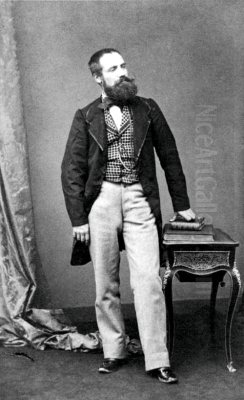
Adolphe Yvon stands as a significant figure in 19th-century French art, particularly renowned for his grandiose military paintings that captured the fervor and tumult of the Napoleonic Wars and the conflicts of the Second Empire. An accomplished academic painter, Yvon's career spanned a period of dramatic political and artistic change in France. His dedication to historical accuracy, combined with a flair for dramatic composition, earned him considerable acclaim and official patronage, though his style also faced criticism from those championing emerging artistic movements. This exploration delves into his life, his artistic education, his major works, his stylistic characteristics, his role as an influential teacher, and his enduring legacy within the annals of art history.
Early Life and Artistic Formation
Born on January 30, 1817, in Eschweiler, a small village in the Moselle department of northeastern France, Adolphe Yvon's early life set the stage for an artistic journey steeped in the traditions of French academic painting. His formative years were spent in a region with a rich, and often contested, history, which may have subtly influenced his later preoccupation with historical and military subjects. Recognizing his artistic inclinations, Yvon eventually made his way to Paris, the undisputed center of the art world in the 19th century.
In Paris, Yvon sought training at the prestigious École des Beaux-Arts, the bastion of academic art in France. This institution was pivotal in shaping generations of artists, emphasizing rigorous training in drawing, anatomy, perspective, and the study of classical and Renaissance masters. The curriculum was designed to produce artists capable of tackling large-scale historical, mythological, or religious subjects, considered the highest genres of painting.
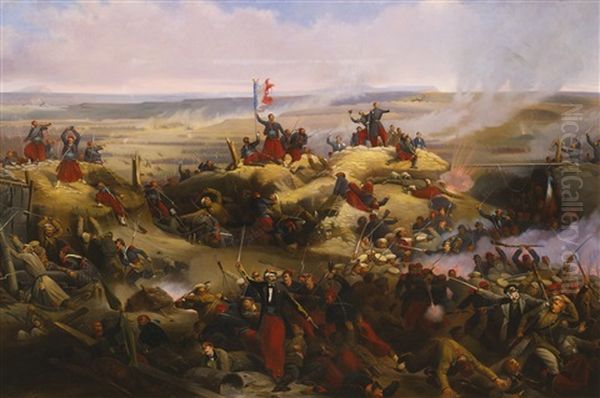
Crucially, Yvon became a student of Paul Delaroche (1797-1856), one of the most celebrated historical painters of his time. Delaroche was known for his meticulously researched and dramatically rendered scenes from French and English history, such as The Execution of Lady Jane Grey and Napoleon Crossing the Alps. Delaroche's influence on Yvon was profound. He instilled in his pupil a commitment to historical veracity, a penchant for theatrical staging, and a polished, detailed technique. Delaroche himself navigated a path between Neoclassicism, as championed by artists like Jacques-Louis David and Jean-Auguste-Dominique Ingres, and the burgeoning Romanticism of painters such as Eugène Delacroix and Théodore Géricault. This synthesis of precision and drama became a hallmark of Yvon's own developing style. Yvon would have also been aware of the grand tradition of French battle painting, exemplified by artists like Antoine-Jean Gros, whose Napoleonic scenes were legendary.
The Ascent During the Second Empire
Adolphe Yvon's career truly blossomed during the Second French Empire (1852-1870) under Napoleon III. This era was characterized by a desire to revive the glory associated with the First Napoleonic Empire, and art played a significant role in this endeavor. Official patronage favored works that celebrated French military prowess, historical achievements, and the figure of the Emperor himself. Yvon, with his skill in depicting large-scale, dramatic historical events, was perfectly positioned to meet these demands.
His reputation was largely built on his monumental canvases depicting battles from the Crimean War (1853-1856) and the Franco-Austrian War (Second Italian War of Independence, 1859). These were not just paintings; they were visual narratives commissioned to glorify French arms and bolster national pride. Yvon often traveled to the sites of these conflicts or worked from detailed accounts and sketches to ensure a degree of authenticity in his portrayals of uniforms, weaponry, and terrain. This dedication to research was a characteristic he shared with other prominent military painters of the era, such as Jean-Louis-Ernest Meissonier, though Meissonier was known for his smaller, incredibly detailed canvases.
The Paris Salon, the official art exhibition of the Académie des Beaux-Arts, was the primary venue for artists to display their work and gain recognition. Yvon was a regular exhibitor, and his dramatic battle scenes often became major attractions, drawing large crowds and extensive commentary in the press. His success at the Salon led to numerous state commissions and official honors, cementing his status as one of the leading academic painters of his generation.
Masterpieces of Conflict: Documenting War
Adolphe Yvon's oeuvre is dominated by his powerful depictions of warfare, works that aimed to immerse the viewer in the chaos and heroism of the battlefield. Among his most celebrated paintings are those related to the Crimean War, particularly the Siege of Sevastopol.
La Prise de la tour de Malakoff (The Capture of the Malakoff Tower)
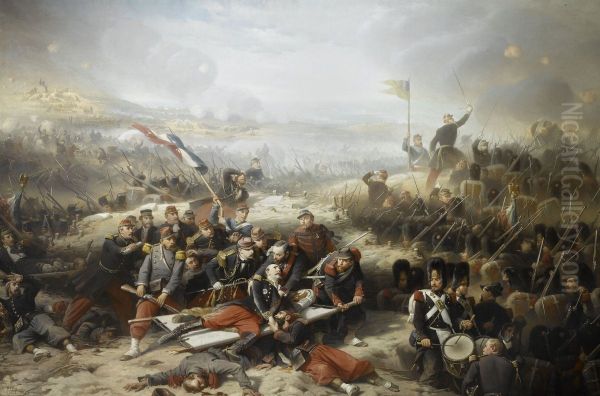
Perhaps Yvon's most famous work is La Prise de la tour de Malakoff, completed in 1857 and exhibited at the Salon of that year. This enormous painting depicts a pivotal moment on September 8, 1855, during the Crimean War, when French forces under General MacMahon successfully stormed the Malakoff redoubt, a key fortification in the defense of Sevastopol. The capture of the Malakoff was a decisive factor leading to the fall of Sevastopol and ultimately to the Allied victory in the war.
Yvon’s canvas is a maelstrom of action. French Zouaves and other soldiers surge forward amidst smoke, explosions, and hand-to-hand combat. The composition is dynamic, with strong diagonal lines guiding the viewer's eye through the melee. Yvon meticulously rendered the details of uniforms, the expressions of the soldiers – a mixture of determination, fear, and fury – and the grim realities of battle. While the painting was a popular success and celebrated French valor, some contemporary critics found its sprawling composition and overwhelming detail to be somewhat chaotic, lacking a single, clear heroic focus in the tradition of earlier battle painters like Gros. Théophile Gautier, a prominent critic, acknowledged its power but also noted the difficulty of conveying such a vast and complex event on a single canvas. Despite these critiques, the painting was widely reproduced, becoming an iconic image of the Crimean War. The challenges Yvon faced included balancing the desire for an accurate, panoramic overview with the need for a coherent artistic composition, and depicting the brutal violence of war without alienating the audience or losing a sense of French triumph.
La Gorge de Malakoff (The Malakoff Gorge) and La Courtine de Malakoff (The Malakoff Curtain Wall)
Following the success of La Prise de la tour de Malakoff, Yvon produced other works related to the same campaign, such as La Gorge de Malakoff and La Courtine de Malakoff. These paintings further explored different aspects and moments of the intense fighting around the Malakoff fortifications, showcasing his ability to sustain a high level of detail and drama across multiple large-scale compositions. These works, often exhibited together or in sequence, provided a more comprehensive visual narrative of the French military efforts.
La Bataille de Solférino (The Battle of Solferino)
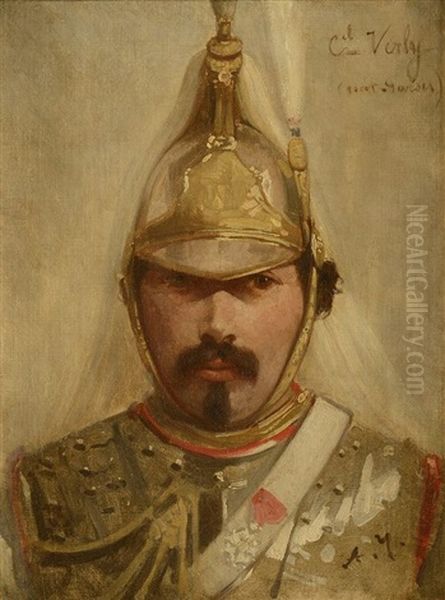
Another significant military painting by Yvon is La Bataille de Solférino, depicting the decisive French and Sardinian victory over the Austrians on June 24, 1859, during the Second Italian War of Independence. Napoleon III himself commanded the French forces in this bloody engagement. Yvon's painting, commissioned by the Emperor, captures the vast scale of the battle, with sweeping landscapes and masses of troops engaged in combat. As with his Crimean War paintings, Yvon aimed for a sense of immediacy and historical accuracy, highlighting the French army's discipline and the Emperor's leadership. This battle was also notable for inspiring Henry Dunant to found the Red Cross, due to the immense suffering he witnessed. While Yvon's painting focused on the military triumph, the underlying human cost was an unavoidable aspect of such scenes.
Napoleonic Echoes: The First Empire
Yvon also turned his attention to the First Napoleonic Empire, creating works that resonated with the Second Empire's desire to connect with the legacy of Napoleon Bonaparte. One notable example is Maréchal Ney soutenant l'arrière-garde pendant la retraite de Russie (Marshal Ney Supporting the Rear Guard during the Retreat from Moscow), painted in 1856. This powerful work depicts the heroic efforts of Marshal Ney, "the bravest of the brave," during the disastrous retreat from Russia in 1812. The painting emphasizes Ney's stoicism and leadership amidst the suffering and chaos, a tribute to French resilience even in defeat. This subject, focusing on individual heroism within a larger tragedy, allowed Yvon to explore different emotional registers than his more triumphalist Second Empire battle scenes.
Portraiture: Capturing Imperial Dignity
While best known for his military scenes, Adolphe Yvon was also an accomplished portraitist. His most significant work in this genre is undoubtedly his Portrait of Napoleon III (1868). This official portrait was intended to convey the power, authority, and dignity of the Emperor. Yvon employed a realistic technique, paying close attention to the Emperor's features, attire, and the symbolic accoutrements of his office.
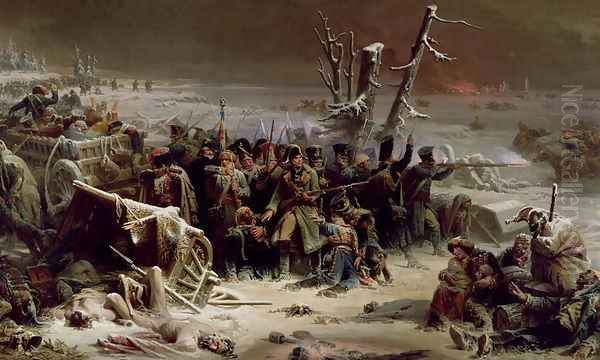
The portrait shows Napoleon III in full ceremonial uniform, adorned with medals, including the sash and star of the Legion of Honour. Yvon's meticulous rendering of the textures of fabric, the gleam of metal, and the details of the Emperor's face – from the characteristic mustache and goatee to the weary but resolute expression in his eyes – demonstrates his technical skill. The lighting is carefully managed to create a sense of volume and gravitas, with subtle shadows modeling the face and a warm, rich color palette dominated by reds, golds, and dark tones, enhancing the regal atmosphere. Yvon reportedly had several sittings with the Emperor to ensure accuracy and capture his likeness effectively. The resulting portrait was well-received by Napoleon III and became an official image of the ruler, displayed in prominent locations and reproduced for wider dissemination. It stands as a fine example of Second Empire official portraiture, comparable in its intent, if not always in style, to portraits by artists like Franz Xaver Winterhalter, who also famously painted European royalty, including Napoleon III and Empress Eugénie.
Artistic Style and Technique
Adolphe Yvon's artistic style was firmly rooted in the French academic tradition. His works are characterized by:
Meticulous Draughtsmanship: Drawing was the foundation of academic training, and Yvon was a skilled draftsman. His figures are well-defined, and his compositions carefully planned.
Historical Accuracy: Yvon went to great lengths to research the historical details of his subjects, including uniforms, weaponry, and settings. This lent an air of authenticity to his battle scenes.
Grandiose Scale: Many of his most famous paintings are monumental in size, designed to make a powerful impact on the viewer and to fill the large spaces of public buildings or Salons.
Dramatic Composition: Yvon had a talent for arranging large numbers of figures in dynamic and often complex compositions. He used strong diagonals, contrasting light and shadow (chiaroscuro), and carefully orchestrated action to create a sense of drama and immediacy.
Polished Finish: Consistent with academic practice, Yvon's paintings typically have a smooth, highly finished surface, with little visible brushwork. This emphasis on finish was valued as a sign of technical mastery.
Rich Color Palette: While his colors could be somber in scenes of hardship, he often employed a rich and varied palette, particularly in the depiction of colorful military uniforms and ceremonial occasions.
However, Yvon's style was not without its critics, especially as new artistic movements like Realism (championed by Gustave Courbet) and later Impressionism began to challenge academic conventions. Some critics found his compositions, particularly in the large battle scenes, to be overly crowded and lacking a clear focal point or a singular heroic figure, leading to a sense of diffusion. The sheer amount of detail, while impressive, could sometimes overwhelm the overall narrative impact for some viewers. Nevertheless, his ability to manage such complex scenes and convey the energy of battle was widely recognized. His work can be seen as a continuation of the grand tradition of French history painting, adapting it to the specific needs and tastes of the Second Empire. He shared this dedication to historical narrative with contemporaries like Jean-Léon Gérôme, though Gérôme often focused on more exotic or classical historical scenes.
Yvon as an Educator: Shaping Future Generations
Beyond his own artistic production, Adolphe Yvon made a significant contribution to French art as an influential teacher. From 1863 to 1883, he served as a professor of drawing at the prestigious École des Beaux-Arts in Paris. This was a position of considerable influence, allowing him to shape the training of numerous aspiring artists.
His teaching methods would have been grounded in the academic tradition, emphasizing rigorous study of anatomy, perspective, and the old masters. He was known to provide his students with specific themes for composition sketches, such as "The Assassination of Julius Caesar," guiding them on how to approach complex narrative subjects. This focus on composition was crucial for students aspiring to create historical or large-scale figure paintings.
Among his many students were several who went on to achieve recognition in their own right, including artists from France and abroad. Notable American painters who studied under Yvon include:
Christian Schussele (1824-1879), who later became a prominent painter and teacher in Philadelphia.
Alfred Wordsworth Thompson (1840-1896), known for his historical and genre scenes.
William Sartain (1843-1924), who became known for his Tonalist landscapes and figure paintings.
Thomas Eakins (1844-1916), one of America's greatest realist painters, briefly studied with Yvon, though his primary teacher in Paris was Jean-Léon Gérôme. Eakins's emphasis on anatomical accuracy and unvarnished realism, however, diverged significantly from Yvon's more idealized academic style.
Julian Alden Weir (1852-1919), an American Impressionist painter, also spent some time in Yvon's atelier, highlighting the diverse paths Yvon's students would take.
The fact that artists from different countries sought out his instruction attests to his reputation as an educator. His influence extended through his students, who carried aspects of their academic training into their own diverse artistic careers, sometimes adhering to it, other times reacting against it, as was common in the evolving art world of the late 19th century. Other prominent academic teachers of the era included Alexandre Cabanel and William-Adolphe Bouguereau, whose ateliers also attracted international students.
Later Years, Honors, and Legacy
Adolphe Yvon's contributions to French art were recognized with official honors. He was made a Chevalier of the Legion of Honour in 1855, following the success of his Crimean War paintings, and was promoted to Officer of the Legion of Honour in 1867, a testament to his continued prominence and service to the state through his art.
Even after the fall of the Second Empire in 1870, Yvon continued to paint and teach, though the taste for grand military spectacles began to wane somewhat with the rise of new artistic sensibilities. The Franco-Prussian War (1870-1871) and the subsequent establishment of the Third Republic brought a different mood to France, and while military painting continued with artists like Édouard Detaille and Alphonse de Neuville (who often focused on the heroism of the recent, painful defeat), the grand imperial celebrations of Yvon's earlier career were less in vogue.
Adolphe Yvon passed away in Paris on September 11, 1893, at the age of 76. He left behind a substantial body of work that documents a significant period in French history and exemplifies the strengths and characteristics of 19th-century academic art.
His legacy is multifaceted. As a painter, he was a master of the grand historical canvas, particularly in the realm of military art. His works served as powerful visual records of contemporary conflicts, shaping public perception and contributing to the iconography of the Second Empire. While his style might seem traditional compared to the revolutionary art movements that emerged during his lifetime, his paintings possess a technical skill, dramatic force, and historical interest that remain compelling. His works are held in major French museums, including the Musée d'Orsay and the Palace of Versailles, where they stand as important testaments to 19th-century history painting.
As an educator, Yvon played a role in training a generation of artists, transmitting the principles of academic art. Even as those principles were being challenged, the foundational skills he imparted remained valuable.
Conclusion
Adolphe Yvon was an artist of his time, perfectly attuned to the demands and aspirations of the Second French Empire. His monumental battle scenes and dignified portraits captured the spirit of an era that sought to project an image of strength, glory, and imperial grandeur. Trained in the rigorous traditions of the École des Beaux-Arts and under the tutelage of Paul Delaroche, Yvon developed a style characterized by meticulous detail, dramatic composition, and a commitment to historical narrative. While the artistic landscape shifted dramatically during his long career, with the rise of Realism, Impressionism, and Post-Impressionism, Yvon remained a steadfast proponent of academic principles. His paintings, particularly La Prise de la tour de Malakoff and his portrait of Napoleon III, remain iconic images of their time, offering valuable insights into the art, history, and culture of 19th-century France. His role as a respected professor at the École des Beaux-Arts further solidified his influence, making Adolphe Yvon a key figure in the artistic establishment of his day.